Hello everyone.
I would like to start taking photos of both the planets and the Moon and I would appreciate any comments that help achieve the best possible quality.
The equipment I am going to use is a Celestron C8 EDGE and I have 2 Barlows 2x and 3x from Televue.
There are many cameras and the selection is linked to the focal length used and the pixel size.
My first question is, is a high focal length f/20 or f/30 better with a larger pixel size of 5.9, for example, or is better detail achieved with the native focal length and a low pixel size of 1.45 to 2 microns?
I would appreciate any comments to help me buy the best camera for this equipment. After 25 years in deep sky I have bought too many things that were not suitable, I would like to save myself that learning curve in planetary.
Thank you very much for your comments.
|
You cannot like this item. Reason: "ANONYMOUS".
You cannot remove your like from this item.
Editing a post is only allowed within 24 hours after creating it.
You cannot Like this post because the topic is closed.
Copy the URL below to share a direct link to this post.
This post cannot be edited using the classic forums editor.
To edit this post, please enable the "New forums experience" in your settings.
I would suggest the 585MC. On sampling you want your pixel size to be 1/2 of your instrument's resolution at a minimum. If you have small pixels and a long focal length you might get there without a barlow which would be the best situation just because less glass is involved.
|
You cannot like this item. Reason: "ANONYMOUS".
You cannot remove your like from this item.
Editing a post is only allowed within 24 hours after creating it.
You cannot Like this post because the topic is closed.
Copy the URL below to share a direct link to this post.
This post cannot be edited using the classic forums editor.
To edit this post, please enable the "New forums experience" in your settings.
Buy the camera with the lowest RON and the highest QE and chose the focal length to suit. Me, I'm using an ASI662MC or GP-CAM 462M.
|
You cannot like this item. Reason: "ANONYMOUS".
You cannot remove your like from this item.
Editing a post is only allowed within 24 hours after creating it.
You cannot Like this post because the topic is closed.
Copy the URL below to share a direct link to this post.
This post cannot be edited using the classic forums editor.
To edit this post, please enable the "New forums experience" in your settings.
Thank you very much Tony and Andrea. Based on your advice, low pixel size, high QE and low Read noise, I imagine that the options that I mark in blue, at the end of the table, are the most interesting. If we also add the FPS, perhaps the ASI664MC is a great candidate or perhaps the ASI715 MC because it has the smallest pixel size. 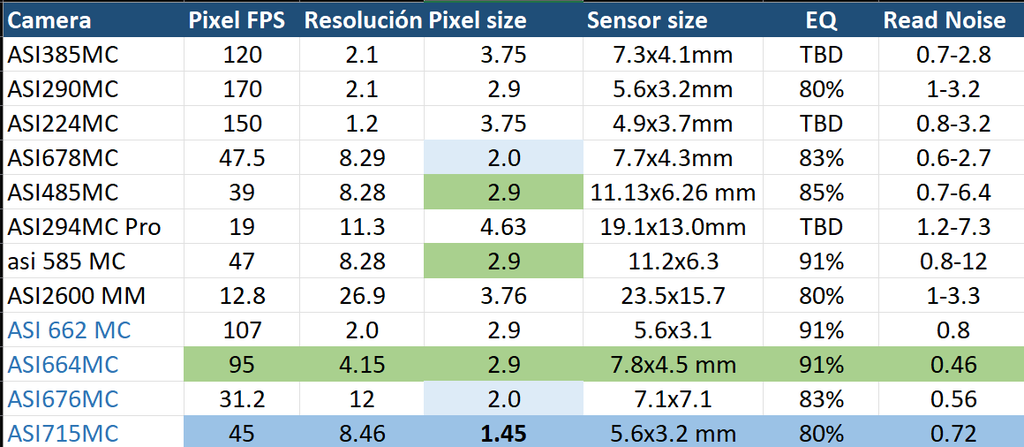 |
You cannot like this item. Reason: "ANONYMOUS".
You cannot remove your like from this item.
Editing a post is only allowed within 24 hours after creating it.
You cannot Like this post because the topic is closed.
Copy the URL below to share a direct link to this post.
This post cannot be edited using the classic forums editor.
To edit this post, please enable the "New forums experience" in your settings.
The ASI662 and 664 are essentially the same camera only the latter has a bigger chip (which is pointless for planetary imaging) and costs more. Both those and the 585 use the same underlying technology at pixel and gate level. The 715 is not as sensitive with no intrinsic advantage over the others. Remember that image scale can be adjusted by varying the camera to barlow distance and that modern barlows such as those from TV introduce essentially zero aberrations.
|
You cannot like this item. Reason: "ANONYMOUS".
You cannot remove your like from this item.
Editing a post is only allowed within 24 hours after creating it.
You cannot Like this post because the topic is closed.
Copy the URL below to share a direct link to this post.
This post cannot be edited using the classic forums editor.
To edit this post, please enable the "New forums experience" in your settings.
A larger chip might be useless for planetary but it's not for lunar. it also makes it a little easier to get that tiny planet on the chip. with any of the larger chip cameras you can use ROI to get the frame rate up so it's really not a disadvantage.
|
You cannot like this item. Reason: "ANONYMOUS".
You cannot remove your like from this item.
Editing a post is only allowed within 24 hours after creating it.
You cannot Like this post because the topic is closed.
Copy the URL below to share a direct link to this post.
This post cannot be edited using the classic forums editor.
To edit this post, please enable the "New forums experience" in your settings.
Tony Gondola:
A larger chip might be useless for planetary but it's not for lunar. it also makes it a little easier to get that tiny planet on the chip. with any of the larger chip cameras you can use ROI to get the frame rate up so it's really not a disadvantage. Thanks Tony, it is curious that the IOTD was Jupiter, taken with a 1800 mm focal length and a 3x barlow with a Player One Uranus-C camera that has the same sensor as the ASI585 MC. The rule to follow is to adjust the focal length so that it is 5x the pixel size, whith a good seeing. In the IOTD we have 2.9 microns x5 it would have to be a focal length of 14.5 and with the 3x barlow and an f/4.5 it achieves the value of 13.5, very close.The focal length used would be 5400 mm In my case, if I buy the ASI585Mc with 2.9 microns x5, I would also have to get a 14.5 focal length, which would be achieved with a 1.5 barlow, but my focal length used would be 3000 mm. Do you think it is enough to get detail? It would be advisable to look for a larger pixel size that allows for a greater focal length. For example, with my f/10, if I used the 3x Barlow I would have a focal length of 30 and dividing by 5 I would need a 6 micron camera. Is this approach correct?
|
You cannot like this item. Reason: "ANONYMOUS".
You cannot remove your like from this item.
Editing a post is only allowed within 24 hours after creating it.
You cannot Like this post because the topic is closed.
Copy the URL below to share a direct link to this post.
This post cannot be edited using the classic forums editor.
To edit this post, please enable the "New forums experience" in your settings.
I have just analyzed a number of cameras to do planetary in Lucky Imaging. Here are my remarks after reading the comments on the forum: There is a parameter for the planetary that is not taken into account and which is in my opinion very important, it is the diameter recorded of the object by the camera. The ASI664MC camera is not at the top if we compare it to the ASI676MC which records a diameter 4.5 times larger. See the 3 Stellarium screenshots of the results obtained at the focus with a C8 with the ASI664MC ROI 2704*1536, the ASI676MC ROI 3552*3552 and the ASI676MC ROI 1776*1766. In these conditions we do not even need a Barlow with the C8. In addition, the performance of the ASI 676MC is 12.6 million pixels against 4.15 Mp for the ASI 664MC. In my opinion, there is no comparison, I just bought the ASI 676MC. Note: It is perfect for planets, but for the Moon you can only do close-ups. (valid for both cameras) clear sky! 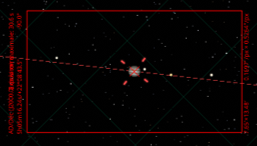 664 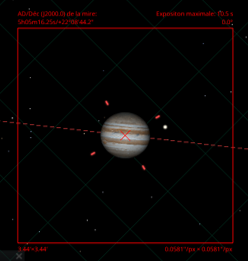 676 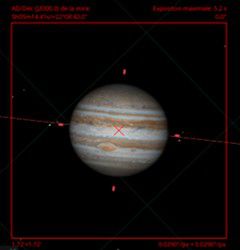 NO
|
You cannot like this item. Reason: "ANONYMOUS".
You cannot remove your like from this item.
Editing a post is only allowed within 24 hours after creating it.
You cannot Like this post because the topic is closed.
Copy the URL below to share a direct link to this post.
This post cannot be edited using the classic forums editor.
To edit this post, please enable the "New forums experience" in your settings.
Leonardo Ruiz:
Thanks Tony, it is curious that the IOTD was Jupiter, taken with a 1800 mm focal length and a 3x barlow with a Player One Uranus-C camera that has the same sensor as the ASI585 MC.
In cloudy nigth I have read that the rule to follow is to adjust the focal length so that it is 5x the pixel size, whith a good seeing. In the IOTD we have 2.9 microns x5 it would have to be a focal length of 14.5 and with the 3x barlow and an f/4.5 it achieves the value of 13.5, very close.The focal length used would be 5400 mm
In my case, if I buy the ASI585Mc with 2.9 microns x5, I would also have to get a 14.5 focal length, which would be achieved with a 1.5 barlow, but my focal length used would be 3000 mm. Do you think it is enough to get detail?
It would be advisable to look for a larger pixel size that allows for a greater focal length. For example, with my f/10, if I used the 3x Barlow I would have a focal length of 30 and dividing by 5 I would need a 6 micron camera. Is this approach correct? I would stick with the CN guide for this. Just remember that it's about the optimal F-Ratio, not focal length, but you've got the point just used the wrong wording. As for the mentioned IOTD it has an F-ratio of about F/13,2 with the 3x barlow, which is fairly close to the 5x value of the pixel size of the camera (2.9um). The 678 is the perfect camera for this scope, at least in theory, as you can use it without any barlows for optimal sampling at F/10. I believe this camera is the most recommended one on CN as well. I rarely, if ever, have good enough seeing to get the kind of images you see as IOTD/TP, but here's the most detailed image I've gotten so far with my 678MC and E8HD. I have more, but they're really poor in comparison due to seeing - which is the real limiting factor when it comes to planetary imaging. As well as having the planets high enough in the sky, which directly relates to how much atmosphere you are imaging through. Saturn is a tough one for me because of this. Apart from the moon/sun all was recently captured with the 678mc and E8HD (not scaled to size at all, mars/saturn have been upscaled a bit in post): 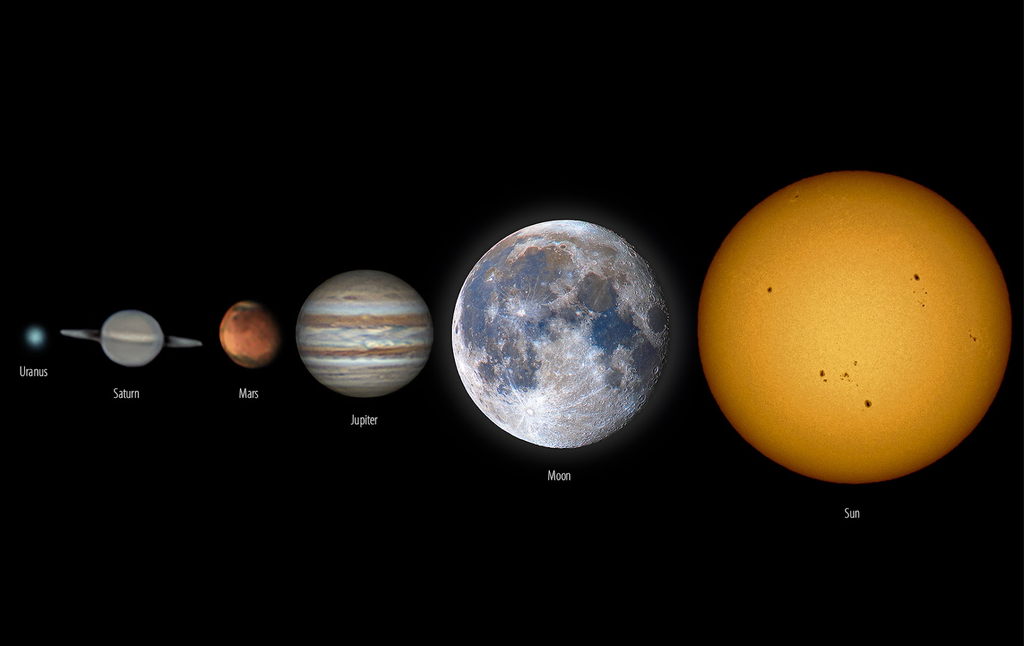 I am considering getting a larger pixel camera as well, in order to use my barlows. As they are on sale atm, from ZWO at least, there are deals to be had. 2.9um should be optimal at F/15 with a 1.5x barlow, 6um (or close enough) should be optimal at around F/30 with a 3x barlow. But again, this is dependant on seeing.
|
You cannot like this item. Reason: "ANONYMOUS".
You cannot remove your like from this item.
Editing a post is only allowed within 24 hours after creating it.
You cannot Like this post because the topic is closed.
Copy the URL below to share a direct link to this post.
This post cannot be edited using the classic forums editor.
To edit this post, please enable the "New forums experience" in your settings.
I use a 662MC with my EHD8 and a 2x Barlow. Here's an image of Jupiter I did with that setup: 
Jupiter with GRS 21 Sep 2022 |
You cannot like this item. Reason: "ANONYMOUS".
You cannot remove your like from this item.
Editing a post is only allowed within 24 hours after creating it.
You cannot Like this post because the topic is closed.
Copy the URL below to share a direct link to this post.
This post cannot be edited using the classic forums editor.
To edit this post, please enable the "New forums experience" in your settings.
Leonardo Ruiz:
Tony Gondola:
A larger chip might be useless for planetary but it's not for lunar. it also makes it a little easier to get that tiny planet on the chip. with any of the larger chip cameras you can use ROI to get the frame rate up so it's really not a disadvantage.
Thanks Tony, it is curious that the IOTD was Jupiter, taken with a 1800 mm focal length and a 3x barlow with a Player One Uranus-C camera that has the same sensor as the ASI585 MC.
In cloudy nigth I have read that the rule to follow is to adjust the focal length so that it is 5x the pixel size, whith a good seeing. In the IOTD we have 2.9 microns x5 it would have to be a focal length of 14.5 and with the 3x barlow and an f/4.5 it achieves the value of 13.5, very close.The focal length used would be 5400 mm
In my case, if I buy the ASI585Mc with 2.9 microns x5, I would also have to get a 14.5 focal length, which would be achieved with a 1.5 barlow, but my focal length used would be 3000 mm. Do you think it is enough to get detail?
It would be advisable to look for a larger pixel size that allows for a greater focal length. For example, with my f/10, if I used the 3x Barlow I would have a focal length of 30 and dividing by 5 I would need a 6 micron camera. Is this approach correct? Well, that rule is giving you an over sampling of approximately 3X which is fine. It really depends on how good your seeing is and how hard you want to push it. The 2X over sampling I mentioned would be considered a minimum. On the last part of your question, it doesn't matter what combination gets you there so you want to go with something practical. Also don't forget that aperture is king in the high resolution lucky imaging game. The best images are taken with large apertures with superb optics under excellent seeing conditions. You can take interesting pictures of Jupiter with a 6" aperture but the best work I've seen was done with apertures in the 14" to 16" range.
|
You cannot like this item. Reason: "ANONYMOUS".
You cannot remove your like from this item.
Editing a post is only allowed within 24 hours after creating it.
You cannot Like this post because the topic is closed.
Copy the URL below to share a direct link to this post.
This post cannot be edited using the classic forums editor.
To edit this post, please enable the "New forums experience" in your settings.
I recently got the ASI676MC for planetary and it has worked well. I have a Celestron 8SE I use with it on an iOptron HEM27 mount. I also have the older ASI662MC and the current ASI585MC Pro. The 585 isd also good for planets and as well for DSO,. as it is cooled. |
You cannot like this item. Reason: "ANONYMOUS".
You cannot remove your like from this item.
Editing a post is only allowed within 24 hours after creating it.
You cannot Like this post because the topic is closed.
Copy the URL below to share a direct link to this post.
This post cannot be edited using the classic forums editor.
To edit this post, please enable the "New forums experience" in your settings.
Doing a little research I see that the 5x focal ratio rule has no scientific basis, it is an approximation that some astrophotographers make. In the November 26, 2024 IOTD example, in fact, it is not fulfilled because the focal ratio is f/20 and its pixel size is 2.9, this rule would recommend a focal ratio of 14.5 instead of 20. In order to analyze it in a scientific way, let's apply some simple formulas. I have asked Chat GTP to give me a summary in English, which is not my native language. I hope it is clear and I apologize in advance for the length, but I think it will help to understand the issue of oversampling and choosing the camera pixel. 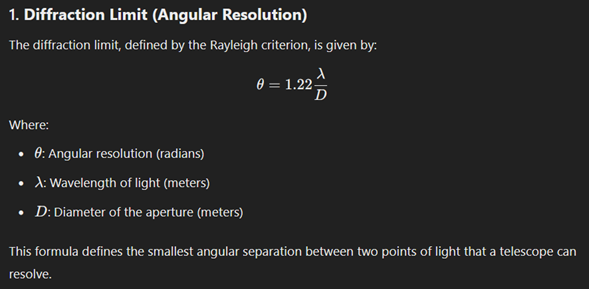 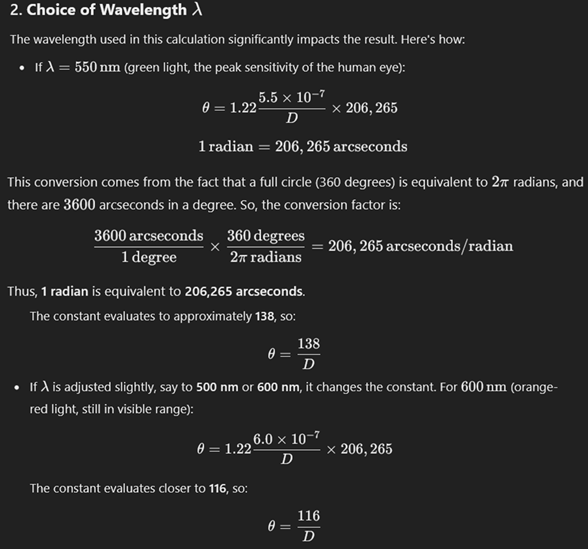 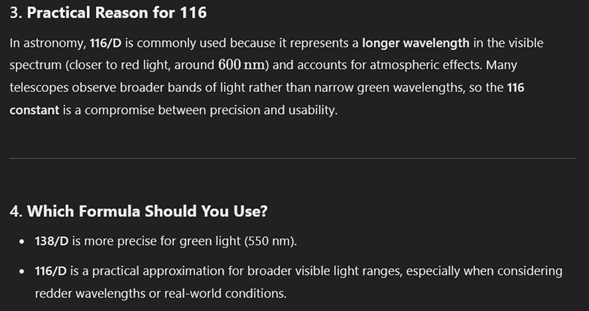 Oversampling is a technique used to improve the resolution of an image or data by sampling at a higher rate than the minimum required by the Nyquist-Shannon theorem. In the context of telescopes and imaging, oversampling refers to capturing more data points than the diffraction limit would suggest in order to improve detail and image quality. Although seeing and theoretical resolution limit what the telescope "sees", oversampling allows capture and post-processing to be optimized to recover finer details within those limits. Techniques such as deconvolution or wavelet sharpening can improve sharpness beyond the apparent visual limits. These techniques need sufficiently detailed data, which requires oversampling. Oversampling ensures that even the smallest details captured by the telescope are not lost in the noise. 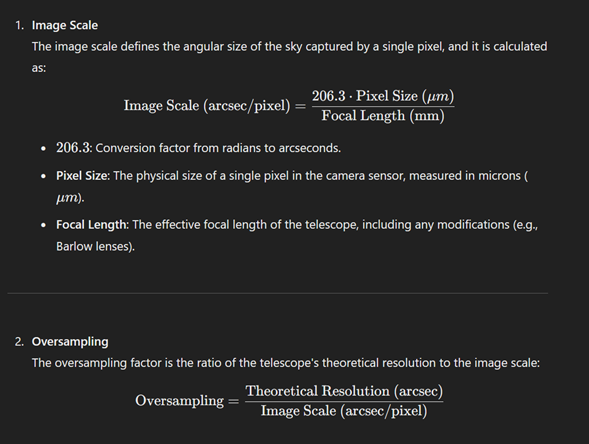 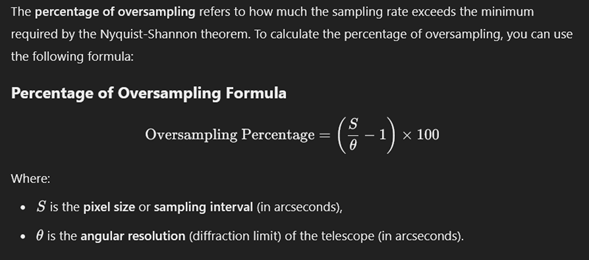 Let's see as an example with the celestron C8 EDGE: 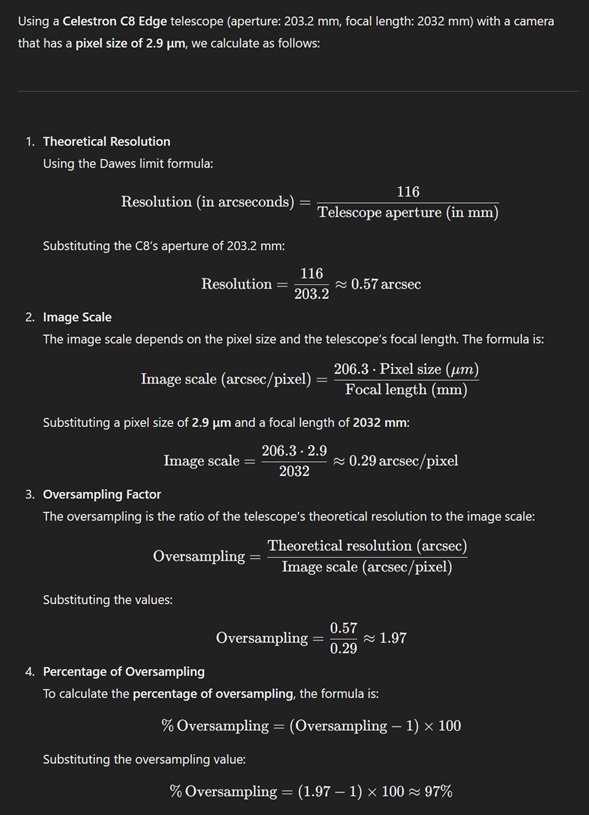 Now we can calculate the oversampling value of all the IOTDs of Jupiter and Saturn,yes, there are a few, to see what minimum and maximum oversampling value the best images have.  Now we can calculate the % oversampling value of the C8 EDGE with all cameras, with each pixel size and see which combinations are between 100 and 300% We have used BIN2x2 to double the pixel size, but that leads to reducing the resolution 4 times. 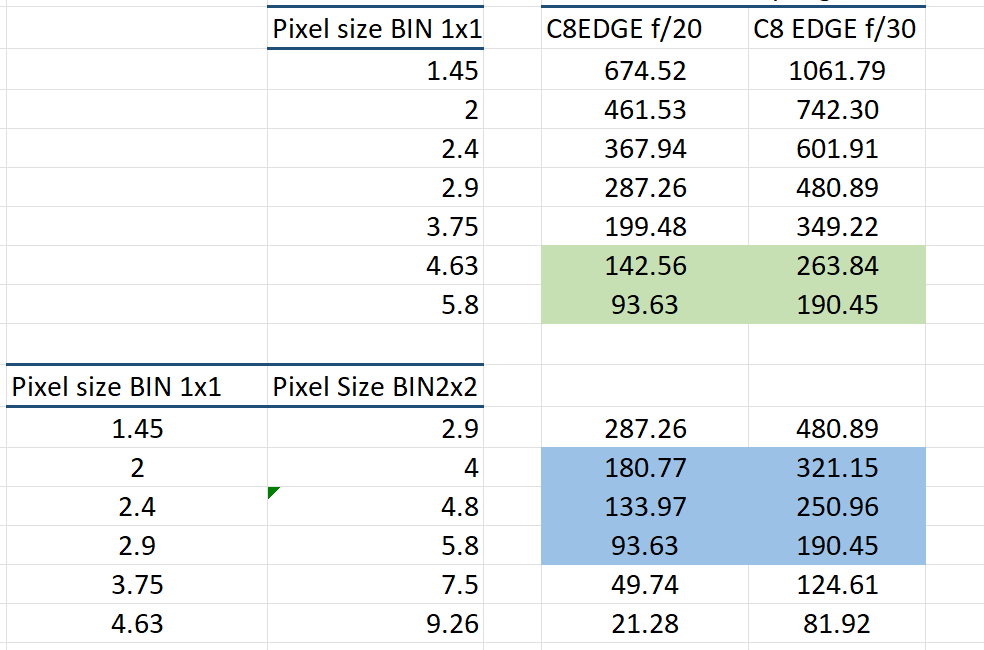 Finally, we select from the initial list of cameras, those that meet this criterion. 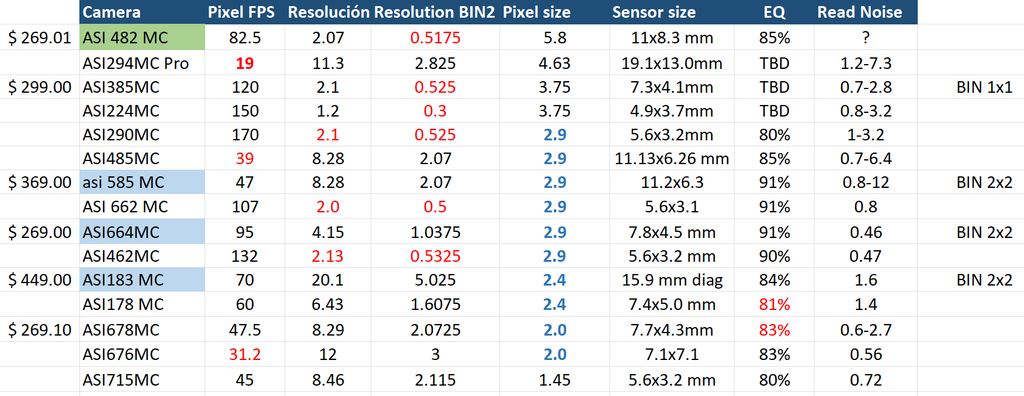 |
You cannot like this item. Reason: "ANONYMOUS".
You cannot remove your like from this item.
Editing a post is only allowed within 24 hours after creating it.
You cannot Like this post because the topic is closed.
Copy the URL below to share a direct link to this post.
This post cannot be edited using the classic forums editor.
To edit this post, please enable the "New forums experience" in your settings.
We remove those that do not meet the oversampling criteria, those that have a resolution less than 1 Mb and those that have a capture speed less than 47 fps and those with lower QE  |
You cannot like this item. Reason: "ANONYMOUS".
You cannot remove your like from this item.
Editing a post is only allowed within 24 hours after creating it.
You cannot Like this post because the topic is closed.
Copy the URL below to share a direct link to this post.
This post cannot be edited using the classic forums editor.
To edit this post, please enable the "New forums experience" in your settings.
Now we need to choose between these 4 cameras. Working at BIN2x2 is normal in deep sky images, but I have never done it for planetary. Normally more noise is generated. Perhaps the best option is to work at BIN 1x1 or choose the one with the least noise to use in BIN 2x2 mode.
I await your comments, since your experience is the final factor. As Tony Gondola said, working up to an oversampling of 3x (300%) is adequate and matches the calculations. He also recommended ASI 585 MC and it is also suitable. Your experience is what I value most.
|
You cannot like this item. Reason: "ANONYMOUS".
You cannot remove your like from this item.
Editing a post is only allowed within 24 hours after creating it.
You cannot Like this post because the topic is closed.
Copy the URL below to share a direct link to this post.
This post cannot be edited using the classic forums editor.
To edit this post, please enable the "New forums experience" in your settings.
Good workup. I don't think you'd want to bin this type of subject unless you needed larger pixels to optimize the sampling. Also, the 585 and other cameras have such low read noise that it's almost a non-factor. Beyond anything else you need very good optics and the best possible seeing, lucky imaging techniques can only do so much.
|
You cannot like this item. Reason: "ANONYMOUS".
You cannot remove your like from this item.
Editing a post is only allowed within 24 hours after creating it.
You cannot Like this post because the topic is closed.
Copy the URL below to share a direct link to this post.
This post cannot be edited using the classic forums editor.
To edit this post, please enable the "New forums experience" in your settings.
Between the ASI 482 MC and the ASI 585 MC, I see that they have identical resolution when the 585 works at BIN 2x2. For planets, the main concern is capturing many frames quickly and improving quality through image stacking, speed (FPS), so I'm going to rule out the ASI 585 MC for having 47 fps, although there are numerous IOTDs at this speed. The FPS and the read noise are much more important than the quantum efficiency and sensitivity, since we will have excess light, I consider the QE to be very important for deep sky, but between 85% and 91% for planetary it should not be a crucial factor.
Therefore, both the ASI 482 MC and ASI 664 MC are suitable options, but in terms of frame capture speed and less noise in each frame, the ASI 664 MC has a slight advantage in terms of read noise and FPS, but It has half the resolution of Bin 2x2.
I will use the ASI 482 MC with native resolution and 1x1 Bin.
I hope I make the right decision.
|
You cannot like this item. Reason: "ANONYMOUS".
You cannot remove your like from this item.
Editing a post is only allowed within 24 hours after creating it.
You cannot Like this post because the topic is closed.
Copy the URL below to share a direct link to this post.
This post cannot be edited using the classic forums editor.
To edit this post, please enable the "New forums experience" in your settings.
Just one more thing. I have looked for the optimal focal ratio formula and if it is 5 times the pixel size. I correct myself.  However, I think it is an approximation, less precise than the calculation I have shown. In my case with 5.8 microns the +optimal focal ratio would be 5x5.8= 29. We'll see if the photos come out better at f/20 or f/30.
|
You cannot like this item. Reason: "ANONYMOUS".
You cannot remove your like from this item.
Editing a post is only allowed within 24 hours after creating it.
You cannot Like this post because the topic is closed.
Copy the URL below to share a direct link to this post.
This post cannot be edited using the classic forums editor.
To edit this post, please enable the "New forums experience" in your settings.
Don't forget that the quoted FPS on these cameras is for full frame. FPS on any of these cameras can be boosted by by using ROI instead of the full frame. This is commonly the way it's done when imaging the planets. A specific image may say it used a 585 but that doesn't mean the capture was done at quoted FPS but likely, much higher.
|
You cannot like this item. Reason: "ANONYMOUS".
You cannot remove your like from this item.
Editing a post is only allowed within 24 hours after creating it.
You cannot Like this post because the topic is closed.
Copy the URL below to share a direct link to this post.
This post cannot be edited using the classic forums editor.
To edit this post, please enable the "New forums experience" in your settings.
Leonardo Ruiz:
Therefore, both the ASI 482 MC and ASI 664 MC are suitable options, but in terms of frame capture speed and less noise in each frame, the ASI 664 MC has a slight advantage in terms of read noise and FPS, but It has half the resolution of Bin 2x2.
I will use the ASI 482 MC with native resolution and 1x1 Bin.
I hope I make the right decision. *No, they are not. The 482 is an old hog with terrible RON. The 664 is a much better solution. Contrary to some people's belief RON is a very important factor in planetary imaging, or better still SNR. Get the 664 and forget about all those formulae. Nearly always you'll be oversampling the seeing at any rate, whichever the effective image scale.
|
You cannot like this item. Reason: "ANONYMOUS".
You cannot remove your like from this item.
Editing a post is only allowed within 24 hours after creating it.
You cannot Like this post because the topic is closed.
Copy the URL below to share a direct link to this post.
This post cannot be edited using the classic forums editor.
To edit this post, please enable the "New forums experience" in your settings.
Thank you Andrea for your comments. I don't understand what RON is, can you clarify please?
|
You cannot like this item. Reason: "ANONYMOUS".
You cannot remove your like from this item.
Editing a post is only allowed within 24 hours after creating it.
You cannot Like this post because the topic is closed.
Copy the URL below to share a direct link to this post.
This post cannot be edited using the classic forums editor.
To edit this post, please enable the "New forums experience" in your settings.
You cannot like this item. Reason: "ANONYMOUS".
You cannot remove your like from this item.
Editing a post is only allowed within 24 hours after creating it.
You cannot Like this post because the topic is closed.
Copy the URL below to share a direct link to this post.
This post cannot be edited using the classic forums editor.
To edit this post, please enable the "New forums experience" in your settings.
You are right Andrea, the RON of the ASI664 Mc is much lower, added to the fact that it is faster and has better QE. I thought the resolution was a decisive factor, but if there is noise the detail will be lost.
I will buy the 664 MC.
Thanks for your comments
|
You cannot like this item. Reason: "ANONYMOUS".
You cannot remove your like from this item.
Editing a post is only allowed within 24 hours after creating it.
You cannot Like this post because the topic is closed.
Copy the URL below to share a direct link to this post.
This post cannot be edited using the classic forums editor.
To edit this post, please enable the "New forums experience" in your settings.



















